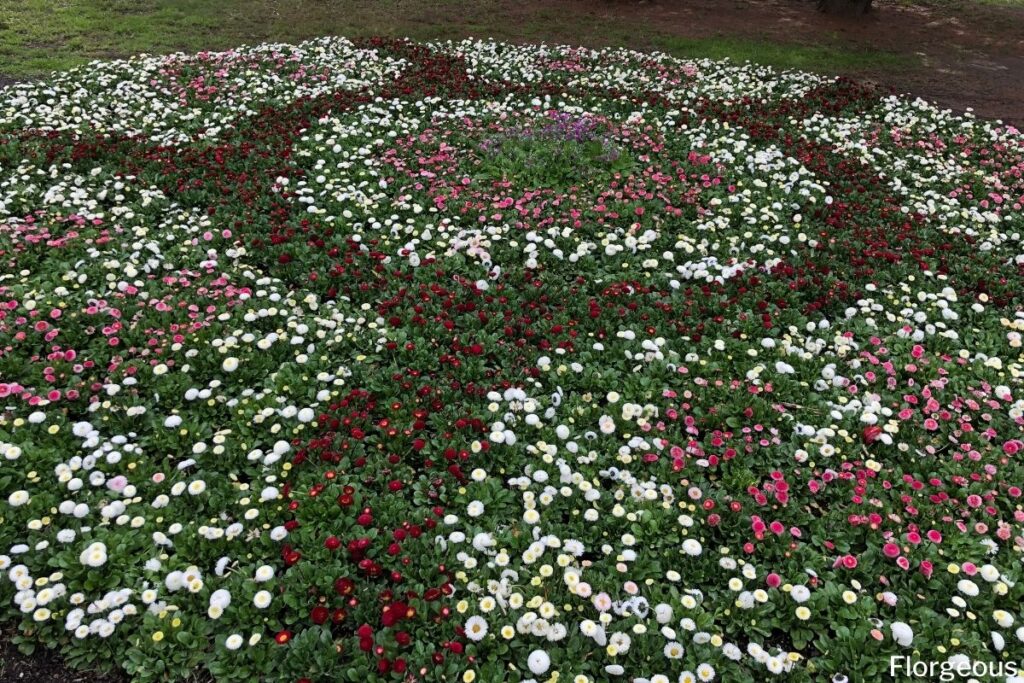If you love flowering plants, you must have thought of growing small flowers at least once. Those tiny blooms full of colors are perfect for any garden, farm, even windowsill. But do you know all about them?
If you are ready to introduce tiny flower plants to your green space, choosing the best seeds is essential. You may want to plant annuals for a quick pop of color or add perennials to enjoy their flowering cycle year after year.
Check out this guide to know more about what tiny flowers are best for your needs. After all, there is always space for an extra plant!
Why Grow Small Flowers?
Growing tiny flowers is a big part of the joy of gardening. Whether you live in a dry climate, in hot regions, or cooler areas, you want to find a way to brighten up otherwise dull or colorless spaces.
Plants that have little flowers are excellent additions to mixed bloom containers, existing potted specimens, or rockeries. If foliage plants decorate your garden, petite blooms will be the cherry on the cake!
You can sneak small flowers in and around your foliage or use them to decorate plant bowls. No matter the reason, small abundant blooms will provide that “wow” factor to your garden throughout the year.
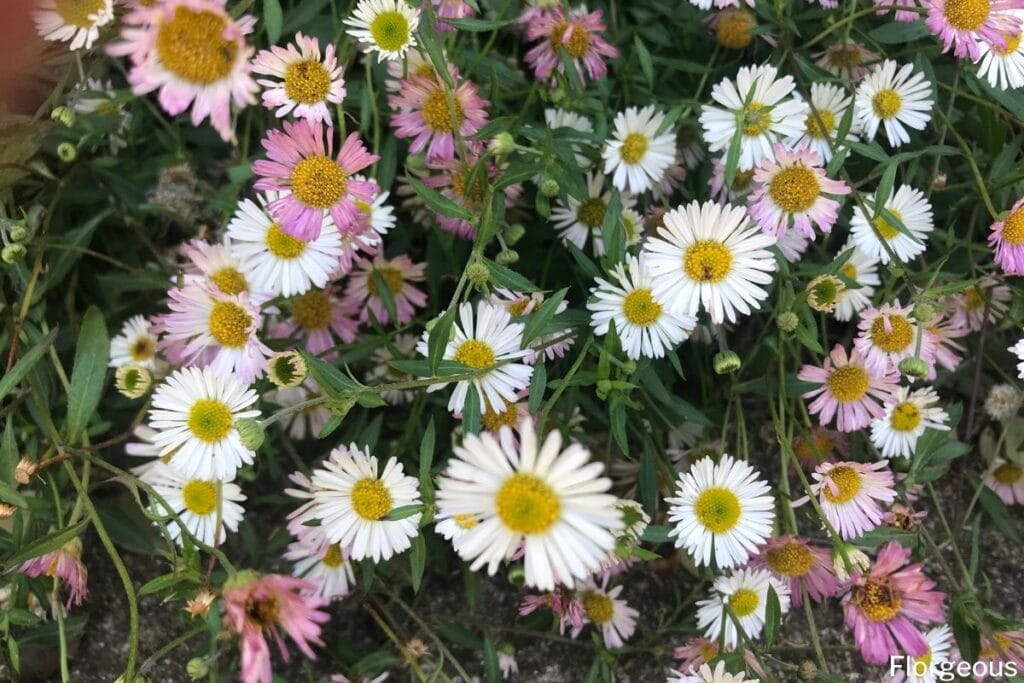
What Are The Best Small Flowers to Grow?
While big flowers such as dahlias and sunflowers have a big presence in your garden, you may want to consider some filler-type blooms as well. Small flowers can make a big impact when they grow abundant, leaving your garden with lots of varieties and colors to choose from.
Explore our suggestions to pick the best little flowers that will make your garden unique:
#1. Pansy
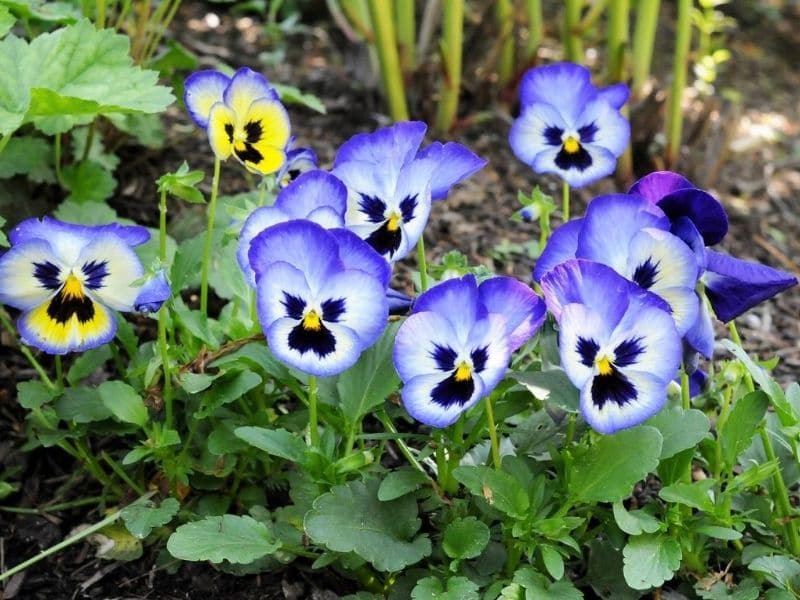
Pansy plants belong to the family of tricolor Violas, originating from a small group of bulbs named Johnny-Jump Up. Growing pansies in your garden will guarantee an amazing variety of colors for your garden’s flower bed.
If your lifestyle is frenetic, and you do not have a lot of time to plant the seeds, you can buy the seedlings directly from your local florist and enjoy them right away. Just remember to water and deadhead for better blooms!
Pansies are short flowering plants. They commonly grow in late fall and early spring, while subtropical areas can enjoy these delicate flowers throughout the winter. Bear in mind that if you opt to plant your seeds, they may take up to two years to flower, since pansies are biennial flowers.
Pansies can resist cooler temperatures much better than many other plants. While you can enjoy pansies most of the year, they can be extremely vulnerable to diseases and fungal spores caused by springtime’s fluctuating temperatures and high humidity. To control the disease, start applying fungicide in early spring and repeat it every two weeks!
#2. Primrose (Primula Vulgaris)
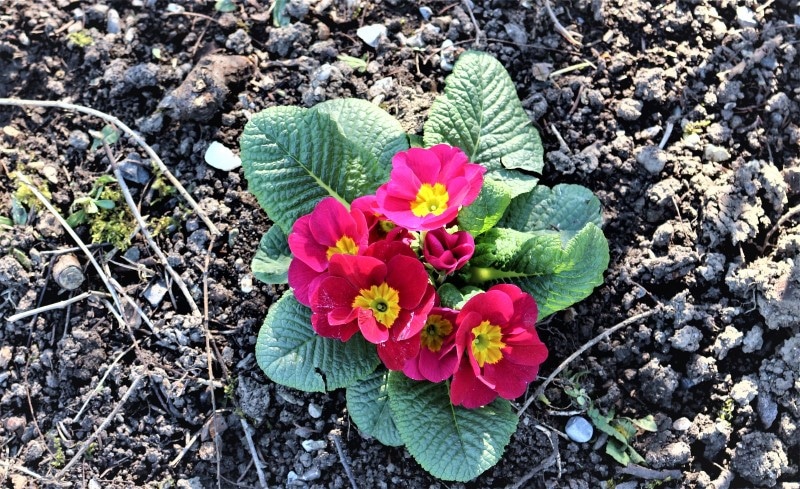
Primula vulgaris, or primrose, is a flowering plant found mainly in Western and Southern Europe, Northwest Africa, and parts of Southwest Asia. The origin of the name is prima rosa, Latin for “first rose.” Primroses are, in fact, among the first flowers that bloom in the Spring. Many varieties produce yellow, red, pink, while and purple flowers.
In optimal growing conditions, you can see primrose flowers blooming in early spring in various forms and sizes. They fill up the landscape with their stunning colors throughout the summer and, in some areas, even during the fall season.
Many types of primrose are suitable for use in garden beds, borders, or containers, but slugs and snails can easily attack these plants, so you must keep an eye on them! Placing non-toxic slug bait around the garden is an effective way to control common pests.
In addition to pests, if primroses do not get enough drainage, they will suffer from crown rot and root rot. But if there is too much moisture, the flower will be susceptible to fungal infections.
As challenging as it may seem, caring for your primroses should not be an impossible mission. To avoid any fungal infection or rotten parts, always adopt good watering habits and make sure there is adequate spacing between each plant.
#3. Baby’s Breath (Gypsophila)
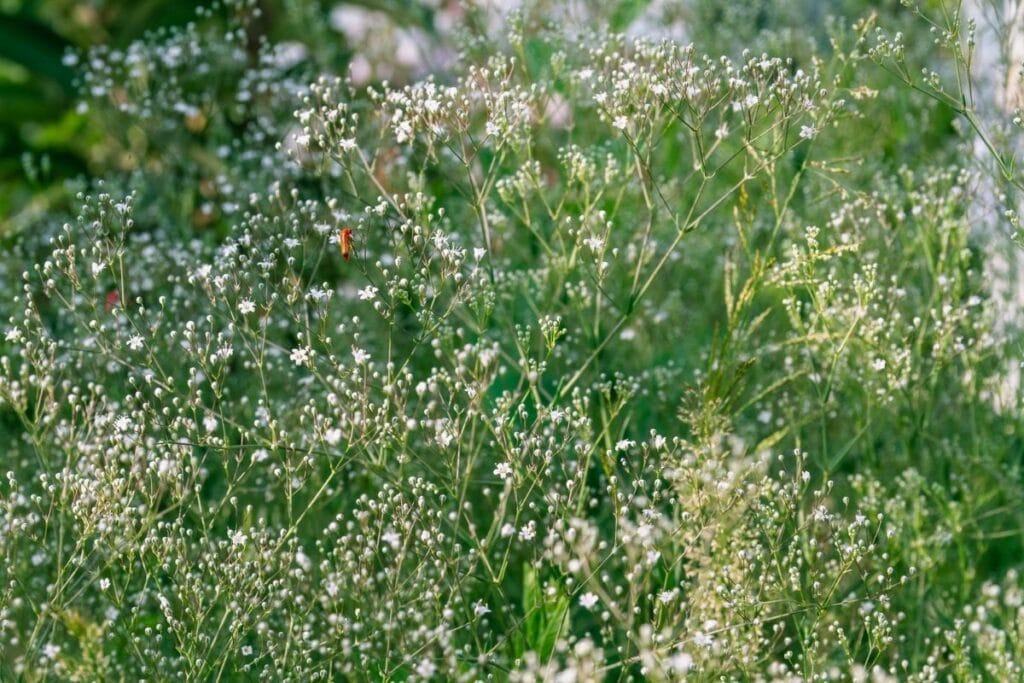
Baby’s breath is a common type of Gypsophila. While you can easily find these tiny white flowers as a filler in Valentine’s Day’s bouquets, this perennial flower can shine in the garden on its own. With its many color varieties, baby’s breath is also a bride’s main flower choice for her big day.
After planting the seeds, you will enjoy clouds of delicate blooms within just one year. The good news is that growing baby’s breaths is easy and low maintenance. They thrive in dry soil, which makes them ideal for rock gardens or container plantings.
Due to their small structure and growing very close to the soil, baby’s breaths are easy victims of aster leafhoppers – tiny green insects that spread aster disease. These leafhoppers initially catch the disease from infected wild plants, and then bring it into your garden, passing it onto your baby breath’s plant.
Another disadvantage of a baby’s breath is the smell. You may find its smell similar to spit, so whether you enjoy it or not will be your choice. Just bear in mind that dry flowers will release high levels of ethylene, irritating asthma sufferers.
The main advantage is that you can find baby’s breath at a very affordable price, as individual plants or large bunches. Its soft appearance will work perfectly with many different settings.
#4. Lobelia
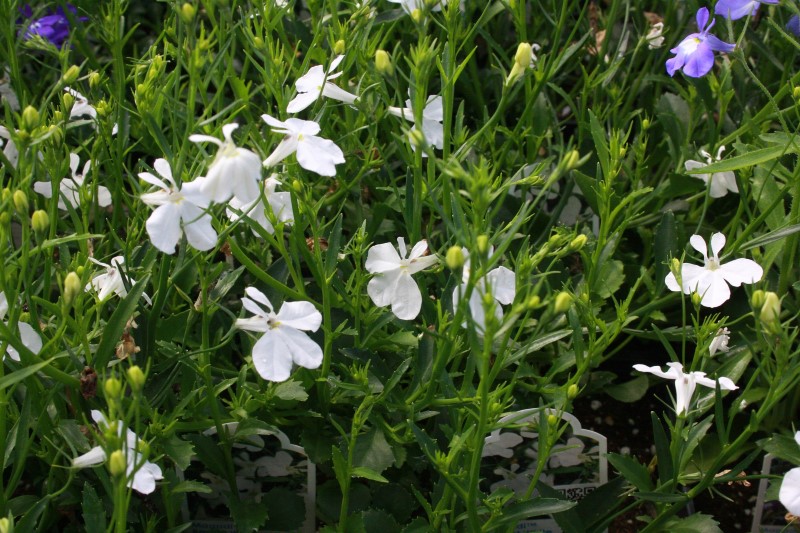
Lobelias grow mainly in tropical and warm climates. Also called cardinal flowers, these light blue and purple blossoms thrive in moist and well-drained settings. Very few species grow into cooler regions.
You will likely find a Lobelia as a filler plant in early spring containers or hanging baskets – especially its true-blue flowers. These attractive flowers will be the perfect ornamental for flower beds. When temperatures get hot, just shear the plant, and keep it hydrated for repeat bloom.
If you buy your perennial lobelia in a pot, you can plant it directly into the ground at any point during the Spring season, making sure you water it regularly.
Another way to stimulate growth and blooming is by adding fertilizer and exposing the plant to full sun or lightly shaded areas. Because of the constant exposure to the light, you will immediately notice lobelias as one of the most flower-bearing plants.
#5. Rock Cress (Arabis)
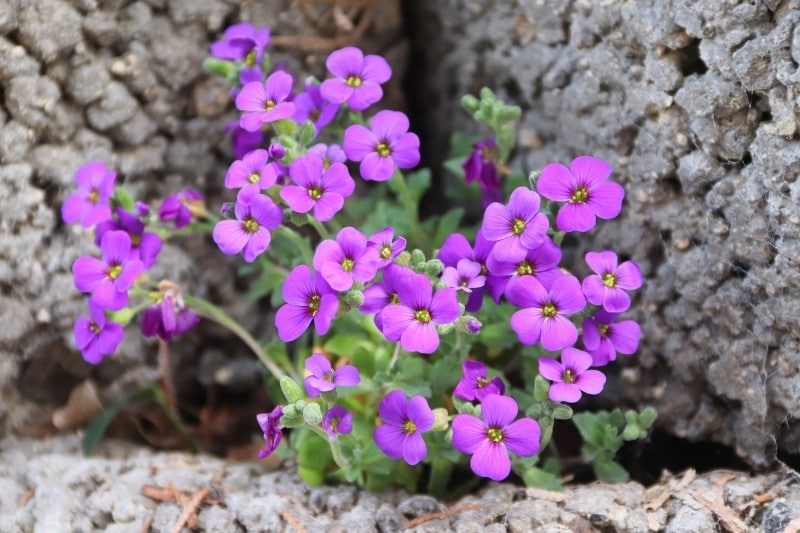
Rockcress is a herbaceous perennial flower belonging to the Brassicaceae family. From April to mid-May, the evergreen ground fills up with pink, purple, or blue flowers on 2 to 4-inch plants. If you are new to gardening, this is your go-to flower! Growing a rockcress requires no special skill.
Rock cresses are alpine plants, so they will thrive where other plants fail, such as on hills and slopes. For this reason, this flower’s main use is as an attractive border in a rock garden or dangling down over a rock wall. It is seldom necessary to treat rockcresses for pests or disease.
As we mentioned, growing rockcress is not difficult. All you would need to do is exposing these flowers to the full sun; they will also tolerate some shade in warmer climates. Water rockcress plants regularly and only when the soil is dry.
#6. Sweet Alyssum
This flowering plant originated in the regions of Cape Verde, Canary Islands, Madeira, and France. Its fragrance is often compared to fresh honey due to its sweet scent.
Today, you can find the sweet alyssum plants by sandy beaches and dunes, as well as on cultivated fields, walls, or calcareous soil.
Whether you opt for buying the plant or just the seed, sweet alyssum is easy to grow. You can start setting it out in early spring once the dangers of the frozen winter have passed.
If you live in a temperate area you may be able to enjoy the sweet alyssum all year long, even during fall and winter times. What is great about this flowering plant is how quickly the seeds germinate—sometimes in less than a week during Spring!
Caring for a sweet alyssum is not challenging. This plant fits well in the full sun, so you should aim at six to eight hours of sunlight exposure per day. However, you should not keep the fragrant flowers in prolonged dry periods: choose a slightly shaded area if the region is hot and dry.
Keep in mind that if there is too much shade, the leaves and soil will not dry out properly. This will cause the stem to rot or leaf blight. Despite this, sweet alyssum has very few problems. The only diseases that may impact it are grey mold and crown rots.
#7. Snowdrop (Galanthus)
The Galanthus species is native to Europe and the Middle East. Snowdrop flowers can survive frigid winters along with more moderate ones, but keep in mind they do not fit in with warm areas. So, if you live in a hot climate, you may want to reconsider purchasing a snowdrop flower for your garden.
The bulbs are often sold undried. So, you will want to buy your snowdrop flower bulbs and plant them immediately after you receive them. Otherwise, they will easily dry out. They also flower early in the year, so make sure you plant them where you can easily see them. They bloom beautiful small white flowers.
Although they bloom fast, snowdrop flower bulbs are dormant underground from late spring until the following year. So, you need to watch out for the ground in the early summer. Make sure you know where the snowdrops are, so you do not harm the bulbs along the way.
On a positive note, snowdrops are a pest-free plant, and rabbits and deer do not get easily attracted to them. The only problem you may have is with squirrels, who tend to dig up snowdrops planted as dry bulbs.
What is interesting about snowdrops is that they multiply by offsets, which grow attached to the main bulb. After several months, you will notice a dense clump of bulbs. When the flowers fade, the leaves will still be green and vigorous, so you can easily increase your planting.
#8. Impatiens
Also known as Touch-Me-Not, this plant is widely distributed throughout the tropics and Northern Hemisphere. Impatiens flowers are very popular for their bright colors and ability to grow in shady areas.
These small flowering plants can produce blue, purple, while, pink, yellow, red and orange flowers. These bright annuals will light up any dark corner of your yard!
You can easily find impatiens at any florist or garden center. Normally, they are available as well-rooted plants, but you can also buy only its seed or cuttings. Although growing impatiens is quite easy, there are a few things to remember about impatiens care.
Whether you opt for buying the whole root or just the seeds, make sure you keep the bulb well watered until you plant it in the ground. Impatiens flowers are very sensitive to dryness, and if they lack water they may wilt quickly.
Because they are heavily dependent on water, flowers do not do well under full sunlight – they enjoy moist, well draining soil and partial shade to deep shade. For this reason, the best way to use impatiens is in containers, as bedding plants, or border plants.
When you are ready to plant your impatiens out in your garden, you can even place them inches apart, if you like. The closer they are, the faster they will grow to form a uniform bank of flowers. Always remember to water all the areas that do not receive much rainfall.
#9. Forget-Me-Nots (Myosotis)

If you are looking for a pretty plant that no deer or rabbit can bother, forget-me-nots are the way to go. They belong to the family of Myosotis, in which 74 other species are currently included. You can find these flowers in the Eurasia zone and New Zealand.
These blue flowers with bright yellow eyes explode from their stem from May through October, covering the plants like a uniform-colored mat. Although they are short-lived perennial, forget-me-nots can self-seed perfectly in moist areas, blooming all over again for many years.
Just like impatiens, forget-me-nots need very humid and well-drained soil to flourish. This is why you will easily spot them near streams and brooks where the concentration of water is high.
They grow best in shady areas but can also adapt to full sun – though not for many hours.
Although flower care is very minimal, remember that forget-me-nots spread easily.
Therefore, you may want to set them up in areas where no other plants are growing. Shady, wooded areas are excellent for moisture retention, which is essential for the survival of this wildflower.
#10. Geraniums
Last but not least is the geranium flower. The geranium is a favorite of pollinators and can be grown anywhere in which temperatures are at least 65 degrees Fahrenheit during the day. Because of this, they can be grown as annuals in most locations and perennials in the warmest climates.
They love being grown in full sun, where they’ll produce tons of tiny blossoms for you. Geraniums are often grown in hanging baskets but can even be planted in raised beds or containers.
These tiny flowers also benefit from regular deadheading to remove spent blooms – and to encourage additional blossoms!
#11. Fairy Foxglove
Fairy Foxglove, scientifically known as Erinus alpinus, emerges as a delightful choice among tiny flowers that can make a significant impact in your fairy gardens.
This charming perennial, native to alpine regions, is celebrated for its diminutive size and profusion of delicate, tubular blooms in shades of pink, lavender, or white. The compact stature of Fairy Foxglove makes it ideal for rock gardens, borders, or container plantings, injecting a whimsical and enchanting quality to the landscape.
Despite its small size, the plant forms dense mats of vibrant blossoms that attract pollinators, including butterflies and bees.
The adaptability of these beautiful blooms to various soil types and its preference for full sun to partial sun contribute to its versatility in garden design, proving that even the tiniest blooms can leave a lasting and magical impression.
FAQs
What are the smallest flowers?
The Wolffia genus, commonly known as watermeal, is home to some of the smallest flowers. Wolffia globosa, often considered the smallest flowering plant, produces tiny, nearly microscopic flowers that are difficult to observe without magnification.
What flower has a lot of small petals?
The Marigold (Tagetes) is known for its abundance of small, densely packed petals in each flower head, creating a vibrant and intricate display. These petals are typically numerous and finely arranged, contributing to the marigold’s distinctive appearance.
Which of These Small Flowers Bloom All Year Round?
Pansies, lobelias, and sweet alyssum are the best options if you want to enjoy a flowerful garden all year round. Alternatively, you may pick a bulb that blooms only in certain seasons, and still admire the beauty of its colors, shape, and fragrance.
Whether you are a gardening expert or simply a plant amateur, you deserve to choose flowers that will make your garden stand out.
Start with easy-to-grow flowers, and you will be surprised by your inner talent as a green thumb!

